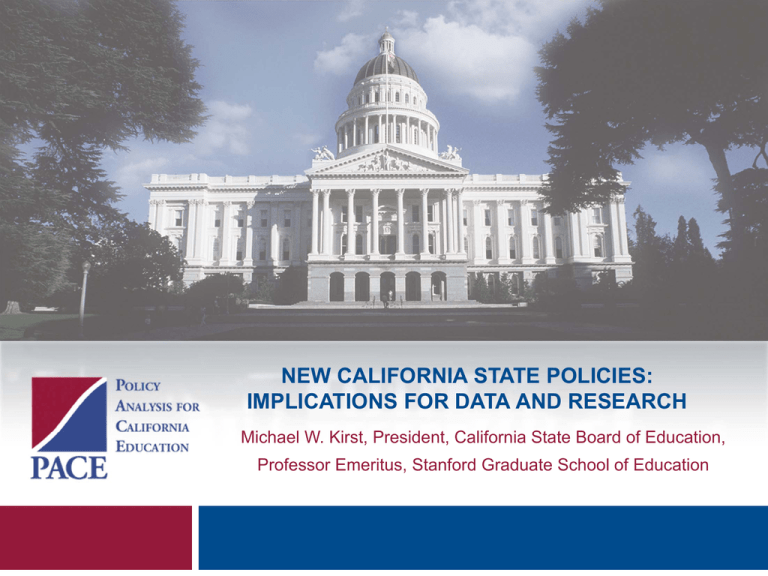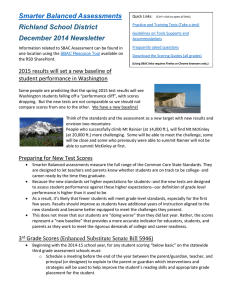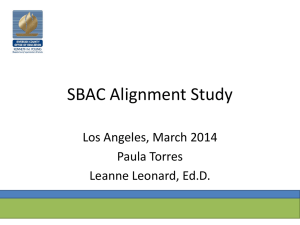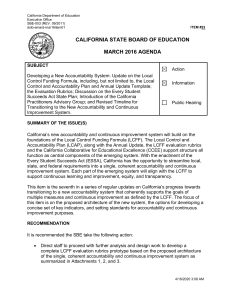NEW CALIFORNIA STATE POLICIES: IMPLICATIONS FOR DATA AND RESEARCH
advertisement

NEW CALIFORNIA STATE POLICIES: IMPLICATIONS FOR DATA AND RESEARCH Michael W. Kirst, President, California State Board of Education, Professor Emeritus, Stanford Graduate School of Education • Common Core and Local Control Funding Formula (LCFF) will disrupt and transform databases and trend analysis. • CST gone and API part of multiple measurement system. • New local finance system creates local accountability plan, linking resources to 8 outcomes. COMMON CORE STANDARDS – MATH • Students should be able to: • “understand,” “describe,” “explain,” “justify,” “prove,” “derive,” “assess,” “illustrate,” and “analyze.” • They also need to be able to: • “model,” “construct,” “compare,” “investigate,” “build,” “interpret,” “estimate,” “summarize,” “represent,” and “evaluate.” • Finally, students should be able to: • “extend” and “apply” their learning to a wide range of real world problems, including uses in science, engineering, and technology problems. COMMON CORE STANDARDS – ELA READING • More emphasis on nonfiction and informational reading. • Draw evidence to support analysis, reflection, and research. • Incorporate more complex reading in science and history/social studies. • Should not extrapolate from CST to SBAC. COMMON CORE POLICY ALIGNMENT CHANGES ASSESSMENTS • Smarter Balanced (SBAC) includes performance, extended response, and multiple choice through computer adaptive engine. • SBAC creates different clusters and domains of skills and applications. • State law prohibits linking Smarter Balanced to CST trends. • SAT, ACT, A-G will align to Common Core. • New High School Exit Exam may result from computer adaptive engine. TEACHER EVALUATION BECOMES MORE PROBLEMATIC • Smarter Balanced will have different “proficiency” levels and concepts (performance exams, teacher scoring). • No assessment trend line during Common Core transition: 2013 – 2016/17. • State Board of Education wary of NCLB waiver requirements during transition. • California will suspend tests in grades 2, 9, and 10, social studies, and most secondary sciences. EIGHT STATE PRIORITIES • Compliance with Williams requirements • Implementation of the academic content and performance standards adopted by SBE for ALL students • Parental involvement • Pupil achievement • Pupil engagement • School climate • The extent to which ALL pupils have access to, and are enrolled in, a broad course of study that includes core subject areas • Pupil outcomes, if available, in the subject areas comprising a broad course of study • Local Control Accountability Plan (LCAP) requires district budgets to link resources to 8 state priorities. • Does the state supplemental funding for needy pupils go to them? • LCAP requires school site plans (School Accountability Report Cards (SARC)) (Revised). POLICYMAKERS WILL NEED IMPLEMENTATION DATA SOON Qualitative data about implementation problems are important: • Local schools may lack capacity/will and adapt state policies. • Depth of professional development for Common Core is a challenge. • Effective teaching strategies are unclear even though 73% of teachers support Common Core. • Longitudinal implementation studies are more positive about local fidelity to state policy approaches. NEW DATA FOR NEW YORK CITY PILOT • Measures of the quality of student class work (e.g., research papers, extended essays, art, and science projects). • Measures including student course outcomes, especially at the elementary and middle school level. • Measures that quantify elements of the quality of classroom instruction, student engagement, supports for teachers and families. • Measures of student academic behaviors and mindsets that are associated with college and career readiness (e.g., persistence, ability to work in teams, effective communication, and “grit”). Source: From Leadership Planning Guide: California – Common Core State Standards and Assessments Implementation. Copyright 2013 (First Edition), by California County Superintendents Educational Services Association (CCSESA).



